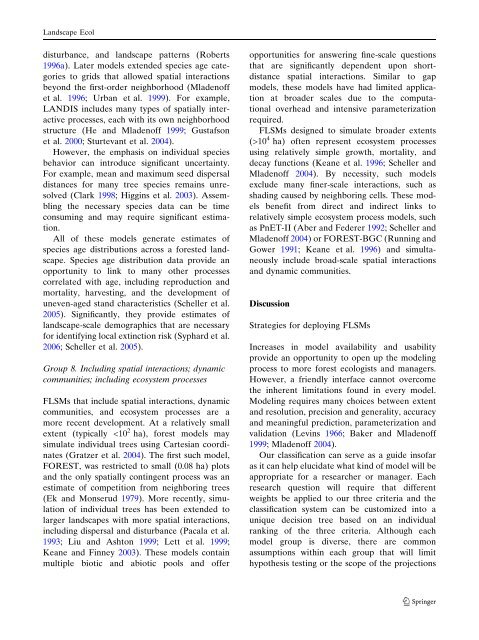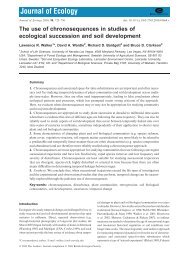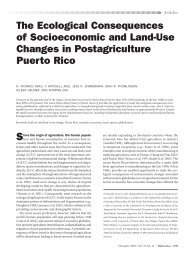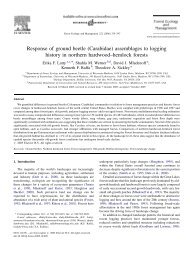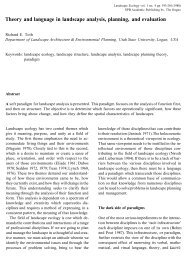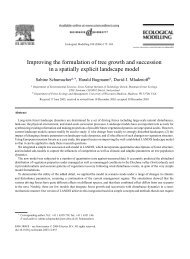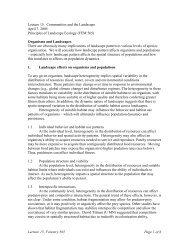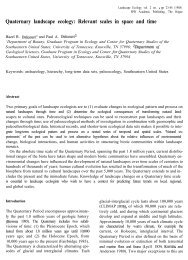Scheller and Mladenoff (PDF) - Forest Landscape Ecology Lab ...
Scheller and Mladenoff (PDF) - Forest Landscape Ecology Lab ...
Scheller and Mladenoff (PDF) - Forest Landscape Ecology Lab ...
- No tags were found...
You also want an ePaper? Increase the reach of your titles
YUMPU automatically turns print PDFs into web optimized ePapers that Google loves.
L<strong>and</strong>scape Ecoldisturbance, <strong>and</strong> l<strong>and</strong>scape patterns (Roberts1996a). Later models extended species age categoriesto grids that allowed spatial interactionsbeyond the first-order neighborhood (<strong>Mladenoff</strong>et al. 1996; Urban et al. 1999). For example,LANDIS includes many types of spatially interactiveprocesses, each with its own neighborhoodstructure (He <strong>and</strong> <strong>Mladenoff</strong> 1999; Gustafsonet al. 2000; Sturtevant et al. 2004).However, the emphasis on individual speciesbehavior can introduce significant uncertainty.For example, mean <strong>and</strong> maximum seed dispersaldistances for many tree species remains unresolved(Clark 1998; Higgins et al. 2003). Assemblingthe necessary species data can be timeconsuming <strong>and</strong> may require significant estimation.All of these models generate estimates ofspecies age distributions across a forested l<strong>and</strong>scape.Species age distribution data provide anopportunity to link to many other processescorrelated with age, including reproduction <strong>and</strong>mortality, harvesting, <strong>and</strong> the development ofuneven-aged st<strong>and</strong> characteristics (<strong>Scheller</strong> et al.2005). Significantly, they provide estimates ofl<strong>and</strong>scape-scale demographics that are necessaryfor identifying local extinction risk (Syphard et al.2006; <strong>Scheller</strong> et al. 2005).Group 8. Including spatial interactions; dynamiccommunities; including ecosystem processesFLSMs that include spatial interactions, dynamiccommunities, <strong>and</strong> ecosystem processes are amore recent development. At a relatively smallextent (typically 10 4 ha) often represent ecosystem processesusing relatively simple growth, mortality, <strong>and</strong>decay functions (Keane et al. 1996; <strong>Scheller</strong> <strong>and</strong><strong>Mladenoff</strong> 2004). By necessity, such modelsexclude many finer-scale interactions, such asshading caused by neighboring cells. These modelsbenefit from direct <strong>and</strong> indirect links torelatively simple ecosystem process models, suchas PnET-II (Aber <strong>and</strong> Federer 1992; <strong>Scheller</strong> <strong>and</strong><strong>Mladenoff</strong> 2004) or FOREST-BGC (Running <strong>and</strong>Gower 1991; Keane et al. 1996) <strong>and</strong> simultaneouslyinclude broad-scale spatial interactions<strong>and</strong> dynamic communities.DiscussionStrategies for deploying FLSMsIncreases in model availability <strong>and</strong> usabilityprovide an opportunity to open up the modelingprocess to more forest ecologists <strong>and</strong> managers.However, a friendly interface cannot overcomethe inherent limitations found in every model.Modeling requires many choices between extent<strong>and</strong> resolution, precision <strong>and</strong> generality, accuracy<strong>and</strong> meaningful prediction, parameterization <strong>and</strong>validation (Levins 1966; Baker <strong>and</strong> <strong>Mladenoff</strong>1999; <strong>Mladenoff</strong> 2004).Our classification can serve as a guide insofaras it can help elucidate what kind of model will beappropriate for a researcher or manager. Eachresearch question will require that differentweights be applied to our three criteria <strong>and</strong> theclassification system can be customized into aunique decision tree based on an individualranking of the three criteria. Although eachmodel group is diverse, there are commonassumptions within each group that will limithypothesis testing or the scope of the projections123


